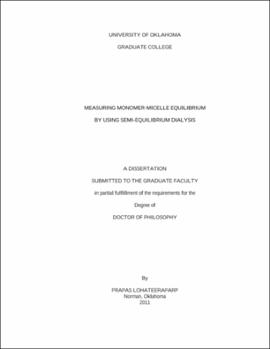| dc.description.abstract | Monomer-micelle equilibrium, the distribution of surfactant species between the monomer and the micelles in solution, dictates many important physical properties of surfactants. Although monomer-micelle equilibrium compositions have been experimentally determined by different methods, there are severe limitations for these experimental measurements (e.g., expensive, difficult to interpret the data, and only applicable to specific systems). The goal of this work is to develop a universal, inexpensive, user-friendly technique to measure monomer-micelle equilibrium. The suitable conditions (e.g., initial total surfactant concentration and electrolyte concentration) to use this technique are determined by the experiments with three single surfactant systems including both ionic and nonionic surfactants. After that, this technique is validated on two model binary surfactant mixtures, SDS/NP(EO)10 and CPC/NP(EO)10, at different surfactant ratios and three different temperatures. The results demonstrate that the kinetic data are necessary to accurately determine the surfactant monomer and micelle compositions from the SED technique. The values of CMC obtained from the SED technique show good correlation with the data from surface tension measurement and predictions from RST. This is very crucial condition for validity of the SED technique. Although the RST describes the CMC data well, the predictions of monomer and micelle compositions from RST can be in gross error when compared to the experimental data from SED technique. In some cases, the SED technique measures a CPC-rich micelle while the RST predicts a NP(EO)10-rich micelle. The SED results at different temperatures also yield enough data to calculate the thermodynamics properties of these studied systems. A calculation of HE, SE and GE values from SED data show that the HE and SE values from RST significantly deviate from the values calculated from experiment data while the values of GE from both SED technique and the RST agree well. | |
